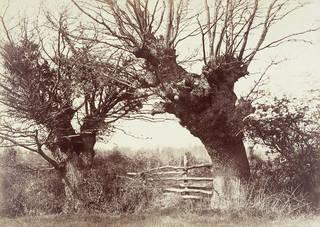One of the first, and greatest, British amateur photographers, Benjamin Brecknell Turner is known for his beautiful early photographs of rural England.

Benjamin Brecknell Turner was born on 12 May 1815 at 31 – 32 The Haymarket, London, the family house above his father's business premises. At 16, he became an apprentice to his father's tallow chandler firm, makers of wax-based candles and saddle-soap. He joined the Worshipful Company of Tallow Chandlers in 1837 and became a Freeman of the City of London the following year. By 1836 the family had moved to Balham in south London, though they returned to the Haymarket following the death of Samuel Turner, Benjamin Brecknell's father, in 1841. Turner inherited the family business along with his younger brother Robert. He married Agnes Chamberlain, a member of the Worcester China family, On 17 August 1847, and they went on to have eight children.
According to the family history, Benjamin Brecknell Turner took up photography in 1849 with a licence from the British scientist and photography pioneer William Henry Fox Talbot. Talbot had invented the Calotype process (creating a 'paper negative' by coating a sheet of paper with silver chloride) in 1840 and patented it in 1841. Talbot's licence cost one guinea and was "for amusement only", as opposed to professional purposes. Turner's early experiments were made with a small camera taking negatives measuring about 15 x 18 cm (6 x 7 inches). He took pictures of his family and household members, the church where he and Agnes married at Bredicot in Worcester, and fishermen with their boats.


From the mid 1850s he built a studio – a 'glass house' above his London business premises – and a darkroom. He made many portraits here, including those of fellow photographers and business associates, although he seems never to have exhibited them. For his large views of rural scenes – made in and around the counties of Worcestershire, Surrey, Sussex, Kent and Yorkshire – he remained loyal to Talbot's paper negative process.

Turner experimented with the photographic process, addressing traditional painterly subjects – landscapes and architecture – to see what could be achieved with the new medium of photography. He tested its ability to capture the flow of water, atmospheric qualities and intricate textures of the natural world. His rural scenes often have a warm, reddish-brown colour and a slightly grainy texture, which suits the rough-hewn qualities of his rustic subjects. Such effects are reminiscent of the watercolours and prints from the period that influenced early photographers.


He began to photograph with new ambition in 1852, and began his long and distinguished career as an exhibitor later that year. Six of his photographs were shown in the world's first purely photographic exhibition, Recent Specimens of Photography, which appeared at the Society of Arts in London, and then toured around England and Scotland. Between 1852 and 1854 he compiled 60 of his photographs under the title Photographic Views from Nature – these superb vintage prints are now in our collection.

Turner was a founding-member of The Photographic Society of London, formed in 1853, and later served as a Vice President. In 1858 he gave the society four of the photographs he had shown in the Society of Arts exhibition of 1852, as well as a copy of Fox Talbot's The Pencil of Nature – the first photographically illustrated book to be commercially published. He also showed his work in the society's annual exhibitions, which began in 1854, as well as in exhibitions in Norwich, Manchester (The Art Treasures of England exhibition of 1857), Edinburgh and Glasgow. He was highly productive and visible throughout the 1850s, his photographic campaigns taking him to many parts of England and to the Netherlands in 1857, taking some of the earliest photographs of Amsterdam. He exhibited in the International Exhibitions held in Paris in 1855 (where he received a bronze medal) and in South Kensington in 1862.

Turner and his family left central London in 1864 for a suburban house in Tulse Hill, south London. He seems to have retreated for a few years from showing his work in public exhibitions. His wife's diary recorded holidays in Cromer, Charmouth, Brittany, Barmouth and Newquay. He showed two prints at the Photographic Society's annual exhibition in 1875, after which he seems to have settled into retirement. Agnes Turner died in 1887 and Benjamin Brecknell Turner himself in 1894.
Aside from their intriguing historical and topographical value, Brecknell Turner's photographs are also creative expressions in their own right and show the clarity, visual sophistication and sheer beauty of his view of rural England during the mid-19th century.


